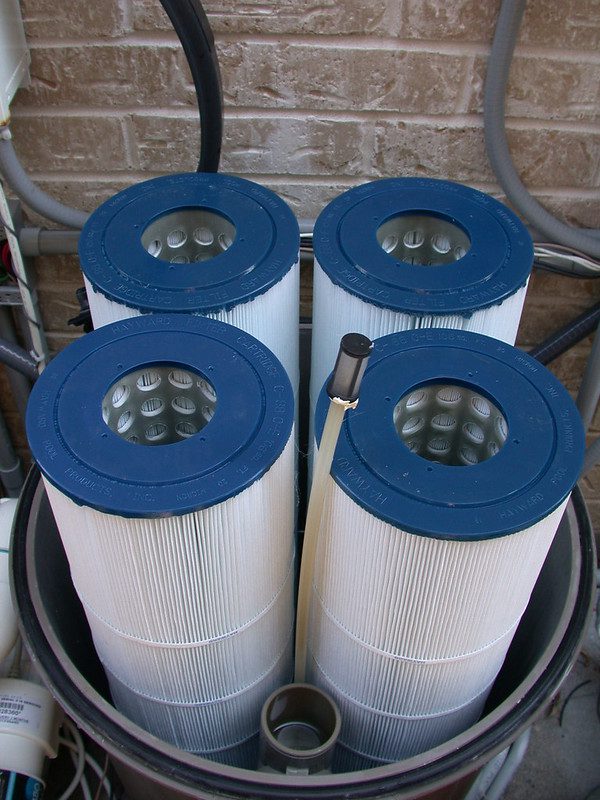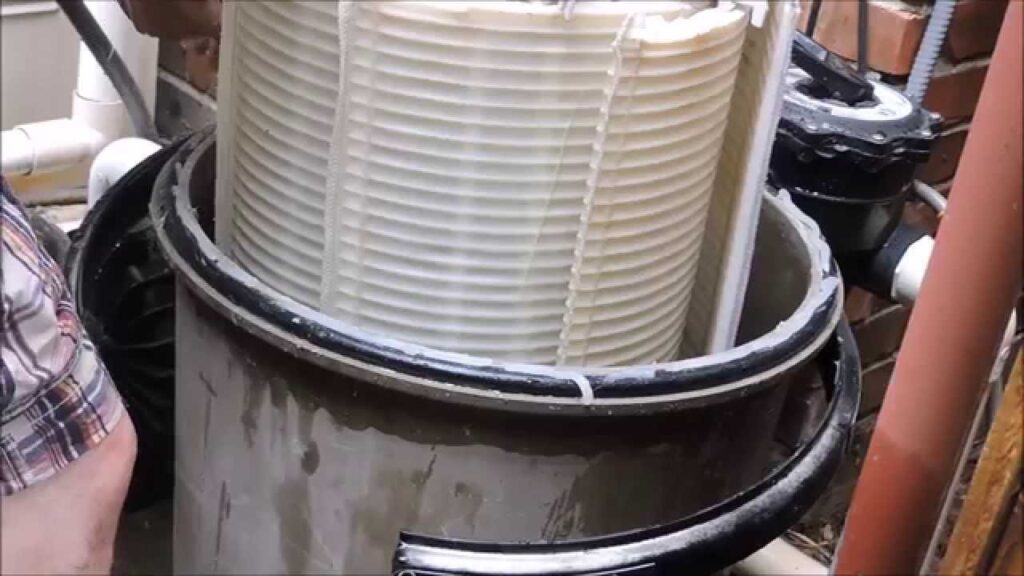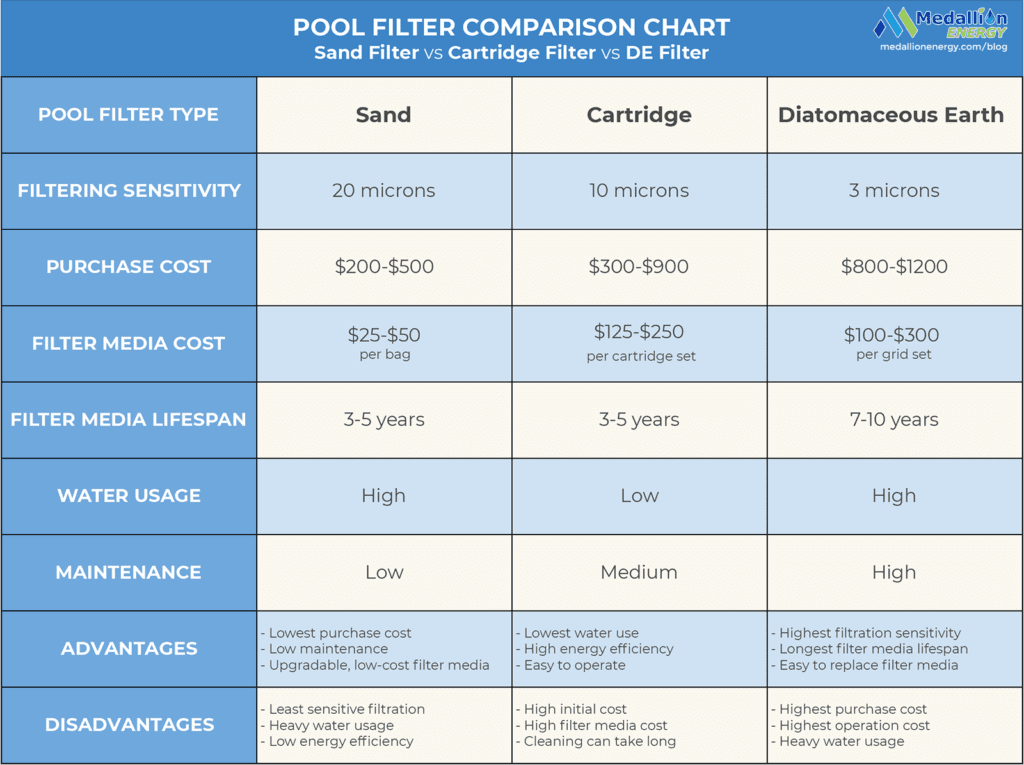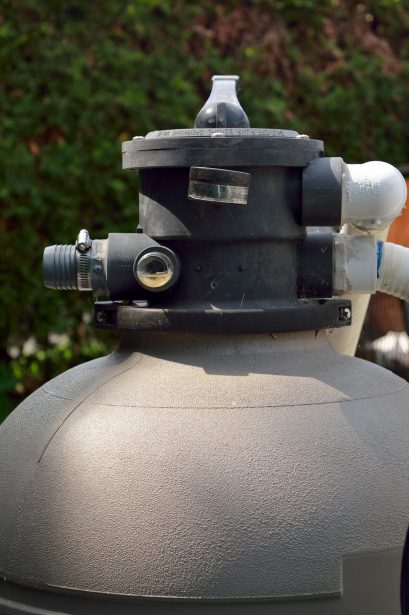How Does A Pool Cartridge Filter Work
Want to know which pool filter is best? Apply this puddle filter comparison to learn everything you need to know about the different types of pool filters.
With options like sand, cartridge, and DE filters, choosing a filter for your swimming pool comes with plenty to consider. Each pool filter works differently and requires different kinds of maintenance. But nosotros're here to make all of that super piece of cake for you with a straightforward pool filter comparison.
Agreement the differences between sand, cartridge, and DE puddle filters makes it easy to choose the best filter for your swimming pool. And in this pool filter comparing, we explain everything from how each pool filter works and what sets them apart, to how much they cost to run. That way, you lot can cull the pool filter that meets your needs and fits your budget.
Then if y'all're ready to find out which pool filter is best, and become an expert on the different types of pool filters, keep reading. We're comparing pond puddle filters in this quick, 5-minute guide that makes choosing a pool filter easy. And we're including a downloadable pool filter comparison chart at the finish of the post to salvage you even more time.
Puddle Filter Systems Comparison Guide
Differences Between Sand, Cartridge, and DE Filters
Sand Filters
What Are Sand Pool Filters?
Sand filters are large tanks that use puddle filter sand to remove contaminants and debris from swimming pool water that flows through. They can remove debris as pocket-sized as 20 microns, which is about a third of the size of a man hair (lxx microns).
They're ane of the most popular and low-maintenance puddle filters available to puddle owners, specially since they but need occasional backwashing and sand replacement once a yr.
How Do Sand Filters For Swimming Pools Work?
As your pool filter pump pushes h2o into your sand filter, it gradually passes through a thick bed of sand. The sand acts as a filter screen that traps debris and removes contaminants, preventing them from getting back into your pool. From there, clean water flows out of the sand filter and into your pool, and the process repeats itself.
Sand Filter Maintenance
Over time, all of the debris and contaminants that your sand filter captures will build up and increase the force per unit area of your sand filter'south tank. And when the force per unit area gauge on your sand filter reads more than 8 PSI college than its original "clean" reading, yous tin lower it by backwashing your sand filter.
Backwashing a sand filter reverses the flow of water to the pool filter pump and acts as a rinse cycle that forces out all of the debris and clay clogging up your filter.
Sand Filter Pool Sand Replacement
Sand filters typically only require pool sand replacement every iii-5 years. This means that you can reuse the aforementioned pool sand throughout the year equally long as you lot regularly maintain and backwash your sand filter.
What Is The Best Puddle Filter Sand?
For the best filtration, pool owners tin utilise glass puddle filter sand, which tin filter contaminants as small as 3 microns. Just let's break downwardly the iii different types of sand filter media, and help you lot decide what the best pool filter sand to use is based on your situation.
- Silica Pool Filter Sand: The standard and almost affordable puddle sand. Filters particles equally small every bit 20 microns. Made from ground quartz
- Zeolite Pool Filter Sand: Sand made from volcanic stone minerals that tin can bind to chloramines to better chlorine rest. Filters contaminants as minor equally ten microns
- Glass Pool Filter Sand: Sand fabricated from recycled glass that tin can trap debris every bit minor as three microns. Capable of trapping algae spores — ideal for pools with algae bug
With puddle sand filter media, you get what you lot pay for. Silica puddle filter sand is the most affordable but offers the least sensitive filtration. On the other manus, drinking glass pool filter sand costs the most merely works the all-time.
Related: 9 Ways To Improve Your Sand Pool Filter
How Do I Choose a Sand Filter For My Pool?
The best way to choose a sand filter for your pool is to size it according to the size of your pool filter pump. This means you should choose a sand filter with a flow rate in GPM (gallons per minute) that'due south more than the max output of your pump.
And then if you're using a pool filter pump that's rated at an output of 100 GPM, you'd need a filter with a flow charge per unit of at least 120 GPM.
In most cases, it's better to cull a large-sized filter over a smaller ane.
Sand Pool Filter: Pros and Cons
Sand Pool Filter PROS
- Lowest initial cost
- Depression-price filter media
- Easy to use and maintain
- Upgradeable filtration ability with zeolite and glass sand
- Pool filter sand lasts long (3-5 years)
Sand Pool Filter CONS
- To the lowest degree sensitive pool filter (without upgrades)
- Heavy water usage: requires regular backwashing (300-500 gallons)
- Non energy efficient with high-pressure level pool systems
Are Sand Or Cartridge Pool Filters Better?
While sand filters work great for nearly pools, cartridge filters offering superior filtration and can trap 50% more contaminants than silica pool sand. That said, sand filter users tin can also improve filtration past up to 50% by upgrading to zeolite puddle filter sand, which offers a like filtering capability to cartridge filters.
Cartridge Filters

What Are Cartridge Pool Filters?
Cartridge pool filters consist of a large plastic tank that houses one to four cylindrical filter cartridges. Each cartridge features a hollow tube that's lined with a layer of folded, or pleated, cloth material. The pleated cloth design increases the surface area of the filter media, which lowers menstruum resistance and allows for more than water to be effectively filtered at once.
Cartridge pool filters can trap and filter out particles equally pocket-sized as 10 microns.
Since they don't crave backwashing, cartridge filters use far less h2o than sand filters and work great for eco-friendly pools, or in states with water usage restrictions.
How Do Cartridge Filters For Pond Pools Work?
Every bit your puddle pump pushes water through your cartridge filter, it passes through a series of pleated, filter cartridges. Each tube features a layer of folded textile that traps debris and particles as water flows through. And as clean water flow outs of the filter, muddied pool water flows in, and the cycle repeats.
Cartridge Pool Filter Maintenance
Cartridge pool filters generally require low maintenance, and simply need the occasional cartridge rinsing every few weeks. That said, rinsing your cartridge can be a little more intensive than other filter cleaning methods, like backwashing a sand filter.
To clean your cartridge filter, remove each cartridge from the filter tank and spray it down with a garden hose. For the best results, make certain to rinse thoroughly between the pleats/folds to remove stubborn debris buildup.
Cartridge Filter Replacement
Cartridge pool filters require cartridge replacement every 3-5 years depending on pool usage. To maintain the all-time functioning, consider replacing your filter cartridges every 3 years.
Cartridge Pool Filter: Pros and Cons
Cartridge Puddle Filter PROS
- Low water use, eco friendly
- Easy to maintain
- Most energy-efficient pool filter type
- Works well for inground and above ground pools
- Good filtration sensitivity: filters particles equally small as x microns
Cartridge Puddle Filter CONS
- Filter cartridges are expensive and need replacement every 3-5 years
- Cleaning cartridge filters takes extra time
- College purchase toll
Diatomaceous Earth Filters

What are Diatomaceous Earth Filters?
Diatomaceous earth filters, or DE Filters, incorporate a series of powder-coated textile grids within a plastic tank. The DE powder clings to the fabric grids, which increases filtration power and allows the DE filter to capture particles as small as 3 microns.
What Is Diatomaceous Earth?
Diatomaceous earth is a naturally occurring sediment made from the fossilized remains of ancient microalgae. It can be crushed and processed into DE powder, which gets added to DE filter systems to improve filtration and capture a effectively range of particles.
How Practise DE Pool Filters Work?
DE pool filters apply a combination of fabric grids and DE powder to capture particles equally they flow through the filter arrangement. A DE pool filter cartridge works best with the assistance of an added layer of DE pulverization that lines each filter grid and helps it capture a wide range of particles equally water passes through.
DE Pool Filter Maintenance
Like sand filters, DE pool filters require backwashing every few weeks. Simply they besides require DE powder replacement whenever there's a backwash.
Afterward backwashing your DE filter, you tin can replace the DE powder past adding a few scoops through your pool skimmer. Since DE filters require regular backwashing and pulverization replacement, their water usage and maintenance costs (DE powder) are higher than other filters.
In addition to regular backwashing, puddle owners should occasionally remove the DE pool filter cartridge and clean it off manually by rinsing it with a hose.
DE Pool Filter Replacement
A DE pool filter cartridge, or grid gear up, will last anywhere from 7-10 years. But after that, they require a replacement.
To replace your DE pool filter cartridge:
- Turn off your filter pump
- Relieve pressure from your pool system
- Open up up the filter tank
- Remove the old grids from the assembly
- Attach the replacement DE filter grids to the assembly
- Identify the assembly back within of the tank
- Close tank
- Add DE pulverisation to puddle skimmer
DE Pool Filter: Pros and Cons
DE Puddle Filter PROS
- Highest filtration power (three microns)
- Long lifespan
- Easy to supplant filter media
- Straightforward cleaning procedure
DE Puddle Filter CONS
- Highest initial costs
- Highest maintenance costs
- Not ideal for states with water usage restrictions
- DE powder can be toxic in powder form if mishandled
Pool Filter FAQs
What Is A Micron?
A micron represents one millionth of a meter and serves as a scientific unit of length used to measure very small objects. For reference, the average strand of human hair has a diameter of well-nigh 70 microns.
In terms of pool filters, microns measure the smallest size particles that a puddle filter can capture. Then while a sand puddle filter tin can trap particles as small every bit 20 microns, a DE pool filter can trap particles much smaller at three microns.
Which Is Ameliorate DE Or Cartridge Filter?
Diatomaceous Earth puddle filters offering higher filtration power than cartridge filters and tin trap 75% more particles. While cartridge filters can capture debris as small every bit 10 microns, a DE filter can trap debris that'southward 3x smaller at 3 microns.
With that said, cartridge filters still offer dandy filtration operation and feature the most energy-efficient operation out of all the types of puddle filters.
What'southward The Best Pool Filter For My Swimming Puddle?
A DE filter is the best pool filter for your swimming pool when it comes to "filtration power" since it can capture smaller particles than any other filter. With that said, the respond to this question as well depends on what's important to you as a puddle owner. Each type of puddle filter has unique advantages over others:
- Best free energy efficiency: Cartridge Pool Filter
- Most affordable: Sand Pool Filter
- Best filtration: DE Pool Filter
Related: nine Essential Tips For New Pool Owners
What Is The Best Pool Filter For In a higher place Ground Pools?
Both sand filters and cartridge filters work great for above-footing pools. Simply the most important thing to think is to cull a filter with a menstruum rate that's higher than your pool filter pump. Then if your above ground pool filter pump has an output of lx GPM (gallons per minute), choose a filter with a flow rate of at to the lowest degree lxx GPM
What Is The All-time Filter System For A Inground Pool?
When it comes to performance, a DE filter is the all-time filter system for an inground puddle. It offers the highest filtration ability and can trap smaller particles than any other type of pool filter.
Simply when it comes to energy efficiency, cartridge filters are the all-time selection. Thanks to their unique design, cartridge filters conserve h2o and limit flow resistance, which keeps your energy bills low. And despite not being as constructive as DE filters, Cartridge Filters still capture a broad range of contaminants and debris.
Po ol Filter Comparison Chart: Sand Filter vs Cartridge Filter vs DE Filter
Have questions most the different types of pool filters? Apply this puddle filter comparison chart to help you choose the best filter for your swimming pool.

If yous liked this post, yous might also like:
seven Cheap Ways To Rut Your Puddle
2021 Pool Heater Comparison & Buyer's Guide
ix Best Ways To Cool Down Your Swimming Pool
Related posts:
How Does A Pool Cartridge Filter Work,
Source: https://www.medallionenergy.com/pool-filter-comparison/
Posted by: hollingsworthageres.blogspot.com



0 Response to "How Does A Pool Cartridge Filter Work"
Post a Comment